A. Lange & Söhne Zeitwerk Luminous Reviewed by Tim Mosso
by Tim Mosso
Clearly, Iron Maiden has a legal claim against A. Lange & Söhne. The heavy metal juggernaut from London coined “The Phantom of the Opera” on its 1980 eponymous album. In 2010, Lange launched a heavy metal watch inspired by an opera clock and dubbed “Phantom.” Brace yourself; this could make Swatch Group vs. Costco look like an episode of Ally McBeal.
I could have been a great attorney.
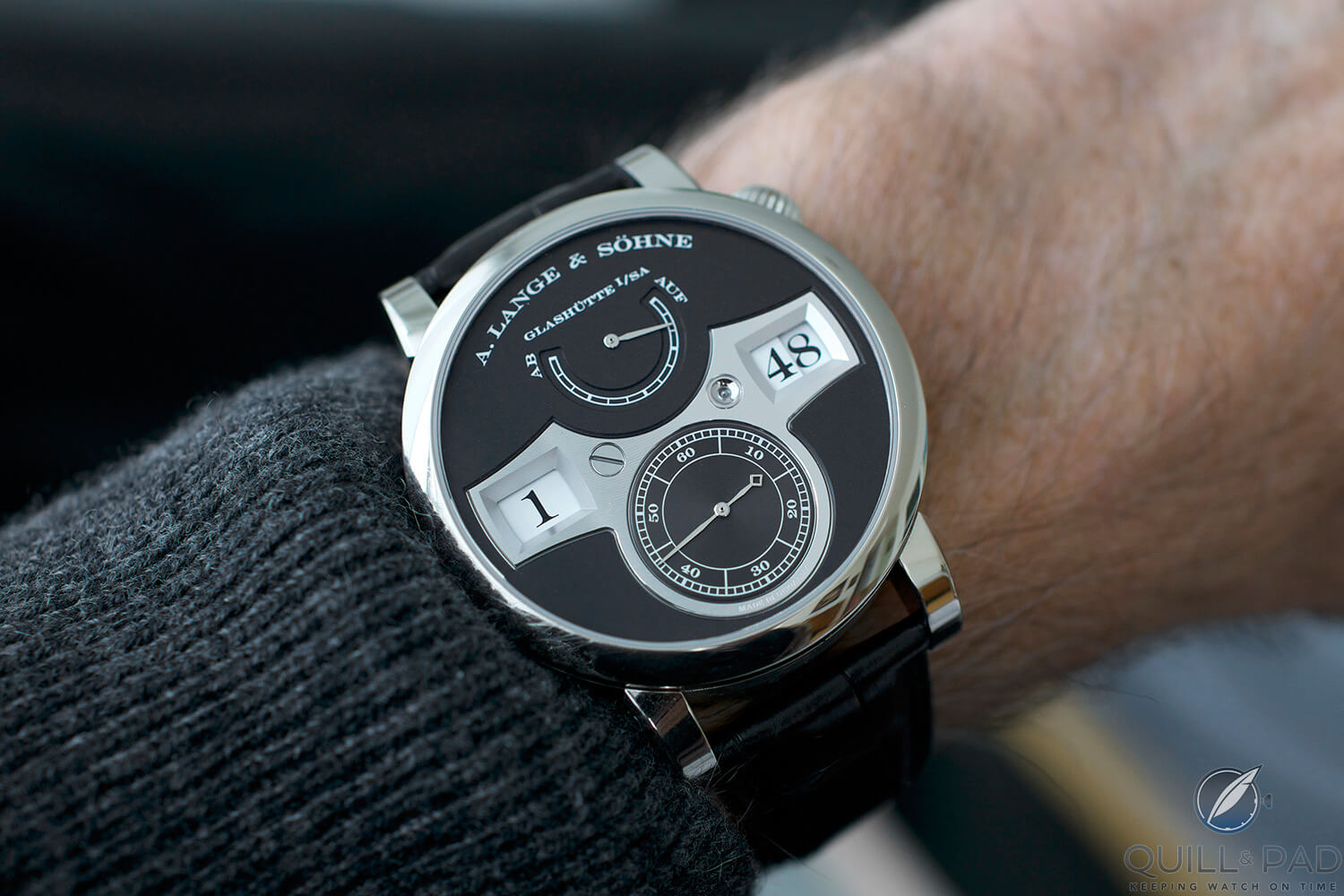
A. Lange & Söhne Zeitwerk
2009’s Zeitwerk digital time watch was a striking departure for a brand known previously for classical – even frumpy – style. Sure, finish always was world class, but the most common collector comment regarding the watches was a general regret that they couldn’t be worn upside down.
Movement-first Lange basically defined the visual vernacular of modern German caliber design in the 1990s, and 1999’s Datograph caliber L951 is credited as the death knell of Patek Philippe’s reliance on Lemania ebauches.
But for all the respect accorded to the cornerstone Lange 1 and the technically ambitious Datograph, they were… pretty much what you’d expect from a Teutonic brand fathered by senior citizen patriarch Walter Lange.
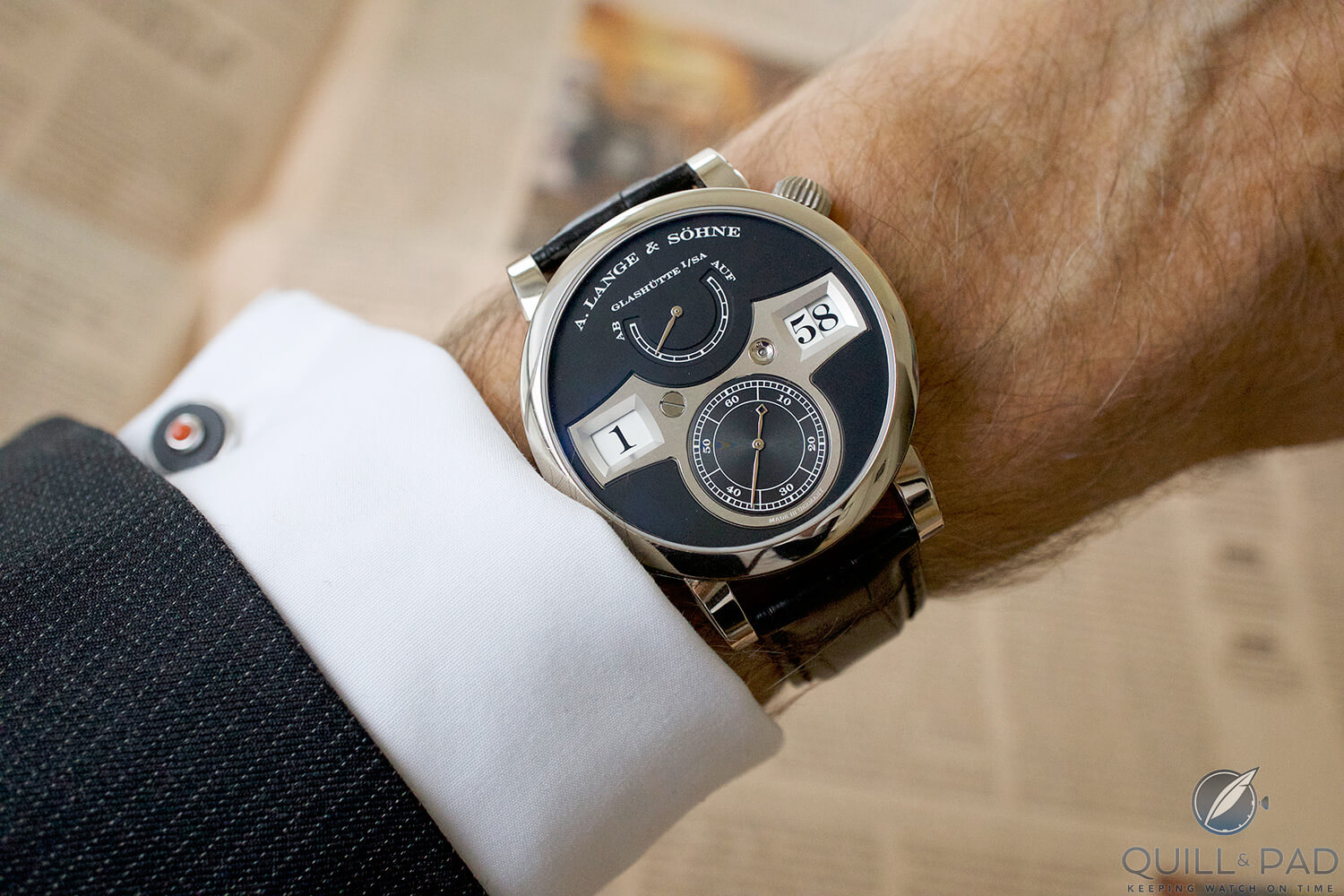
A. Lange & Söhne Zeitwerk
Not so with the Zeitwerk of 2009. A decade removed from the classicism of the Datograph, the Zeitwerk represented a total break with Lange’s conservative streak. Dresden’s Semperoper – opera house – and its nineteenth-century “five-minute” clock drove the aesthetic of the Zeitwerk.
For a tribute to antiquity, the Zeitwerk nevertheless felt shockingly fresh and a clean break with the previous Lange house style. Johann Christian Friedrich Gutkaes’ locally famous clock became an international sensation.
The Zeitwerk was named Aiguille d’Or in 2009. Even today, it’s no mean feat for a German watch to win the equivalent of “Best Picture” at Switzerland’s watchmaking equivalent of the Academy Awards. In the process, the Zeitwerk – instantly – came to be regarded as the third pillar of Lange’s house alongside the Dato and Lange 1.
————————————————————————————————————–
—————————————————————————————————–
2010 brought the hero of today’s tale, a 100-piece platinum edition officially dubbed “Zeitwerk Luminous.” Unofficially, it became the “Phantom,” and later – erroneously – the “Zeitwerk Lumen.” Although this watch is the canonical first entry in the nocturnally radiant “Lumen” series, it didn’t share that subsequent nomenclature at launch, and the official Zeitwerk “Lumen” is the rose gold model of 2021.
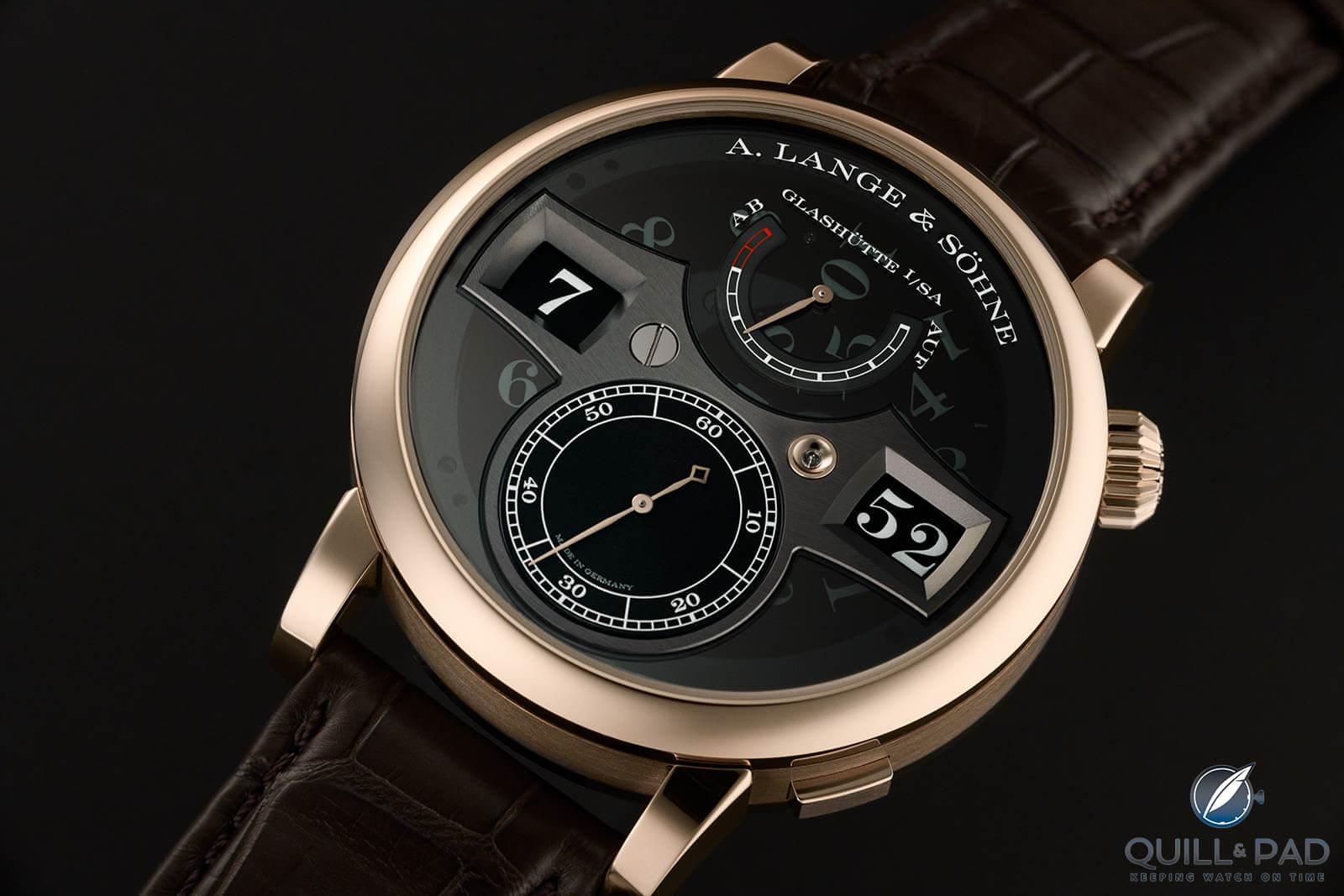
A. Lange & Söhne Zeitwerk Lumen Honeygold
Every Zeitwerk is a frenetic machine, but the Phantom is more so. Lange designers exposed the underlying time discs for two valid but unrelated reasons.
First, the smoked sapphire dial permits sufficient intrusion of UV light to activate the luminescent coating of numerals before they jump into the frames. As a result, the Zeitwerk Luminous continues to serve activated digits long after nightfall or lights-out.
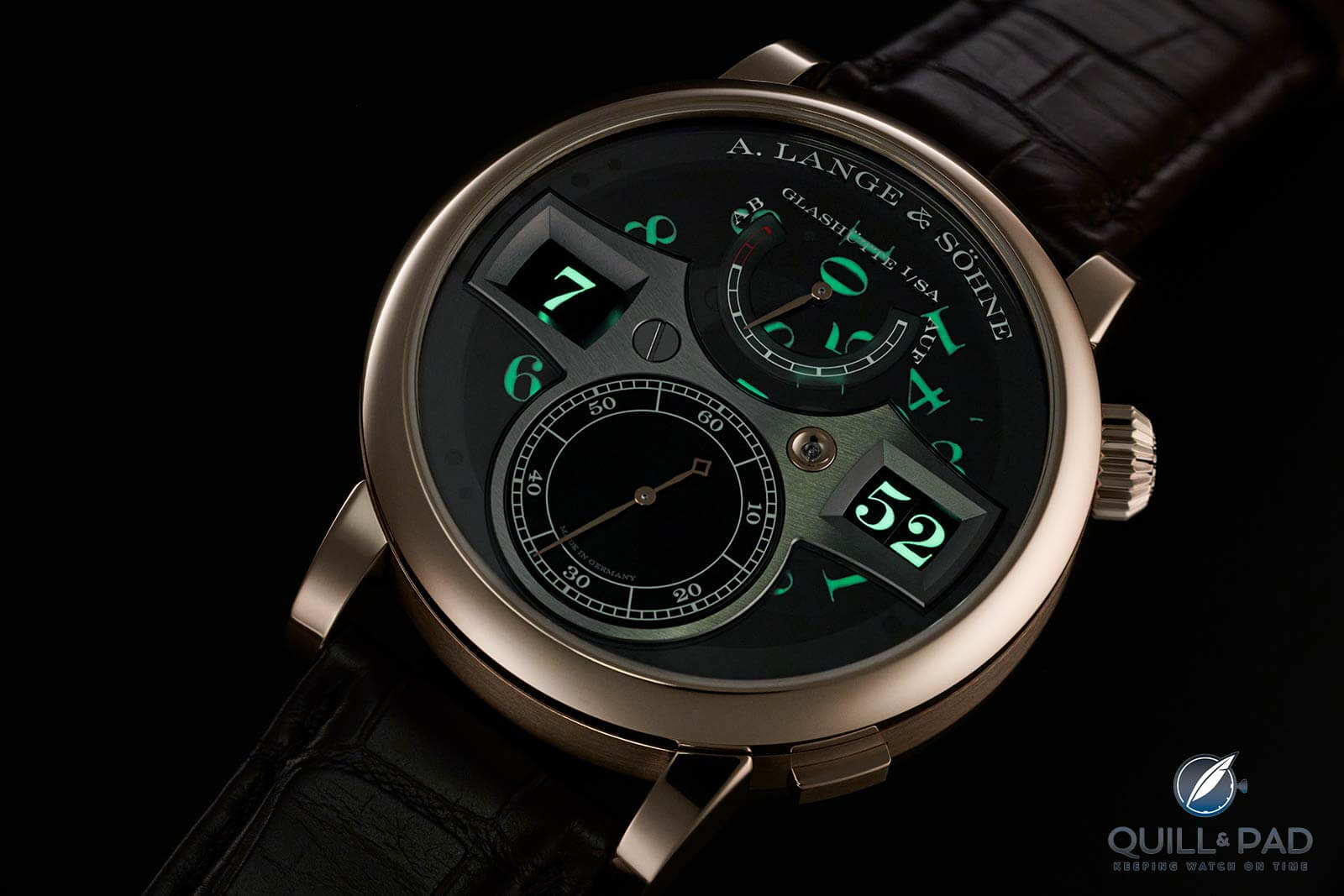
A. Lange & Söhne Zeitwerk Lumen Honeygold lume
The jumble of dimly visible numbers also brings an element of calculated chaos to the watch. It’s almost as though the Second Law of Thermodynamics is overtaking Lange’s otherwise meticulously ordered machine; entropy is rising.
Following its 2009 debut, the dial-dominating “time bridge” was back in black for 2010. Strictly speaking, the prominent frame for the hours, minutes, and seconds is part of the movement of the watch. While the power reserve indicator and black sapphire stand alone as the “dial,” the “bridge” is a piece of German silver that has been blackened for a wicked visual kick.
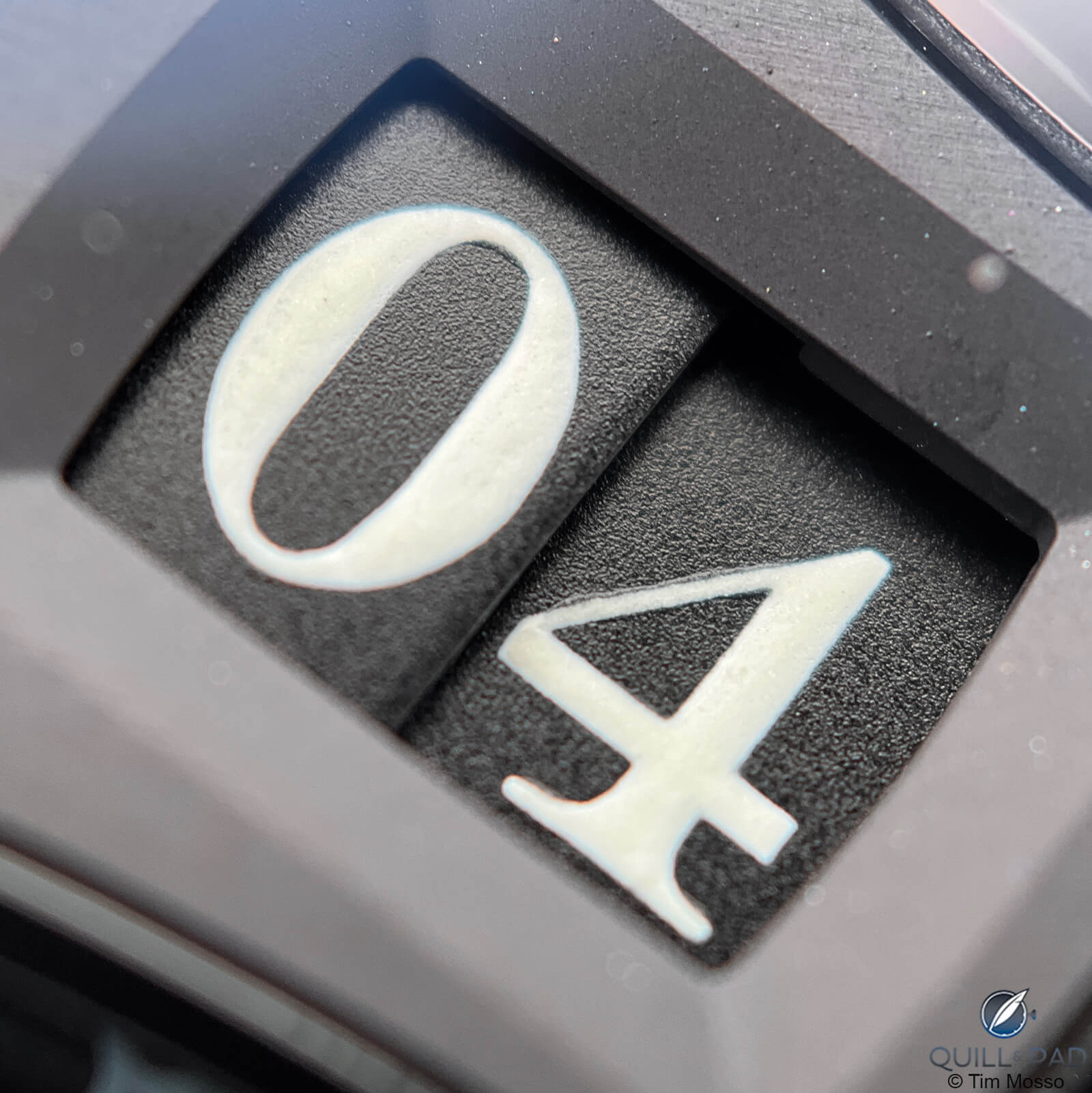
Digital minutes of the A. Lange & Söhne Zeitwerk Luminous
At three o’clock, the clear sapphire cup adjacent to the minutes is the actual pivot jewel on which the two co-axial minute discs revolve. Each of the discs has a matte black base with coarse graining visible under scrutiny.
Not everyone loves the way an early Zeitwerk cycles through minutes. At first, everyone is smitten, but I’ve found that a vocal minority of observers grow to hate the slight priming of the minute disc seconds prior to the full jump. The miniscule displacement is evident only under scrutiny. I couldn’t care less, and popular opinion seems to be with me. But… the people who hate the priming action really hate it.
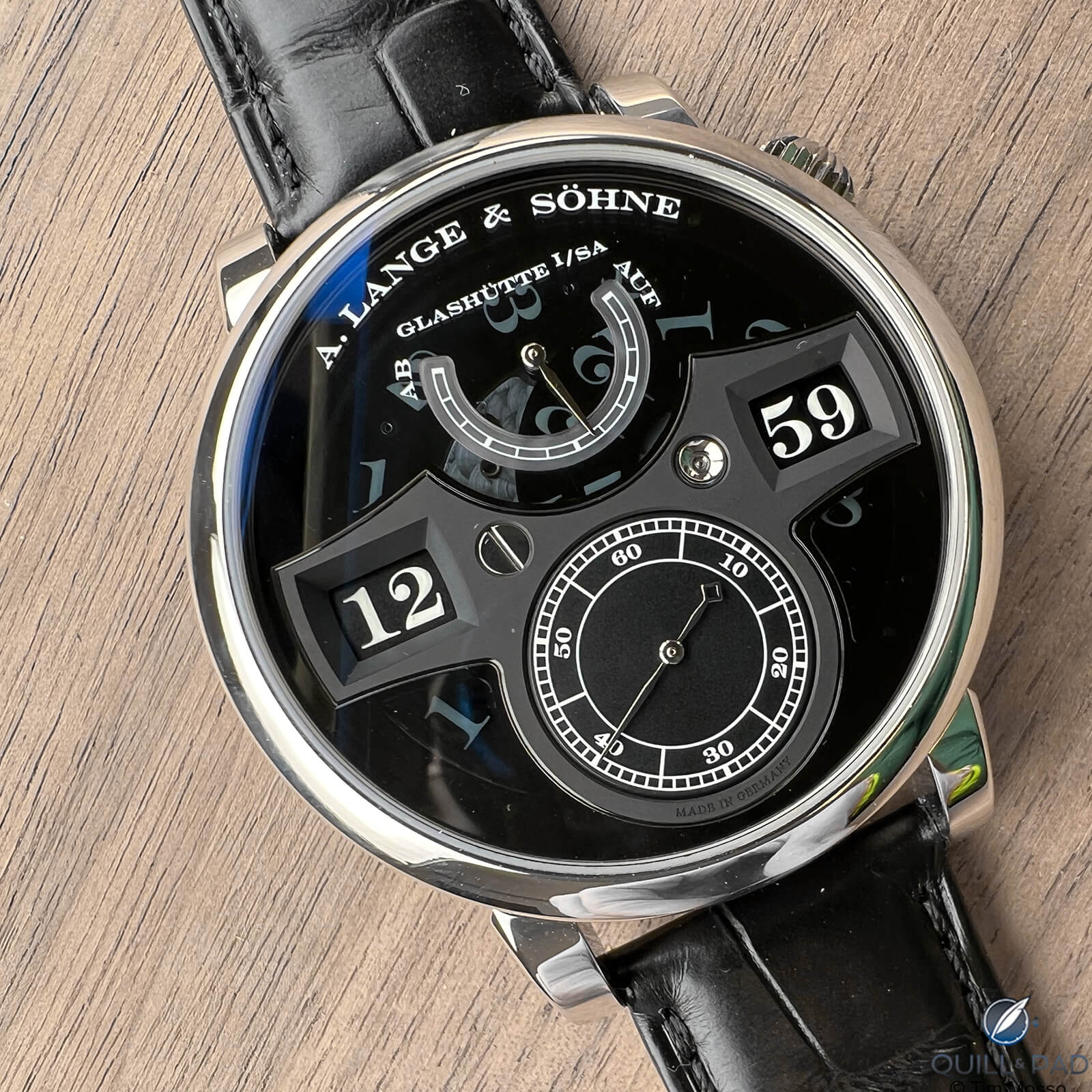
A. Lange & Söhne Zeitwerk Luminous
While later Zeitwerk models minimized or eliminated this tendency, it’s present on this example as it is on most early watches in the series.
—————————————————————————————————–
—————————————————————————————————–
Conversely, setting the Zeitwerk is a universal pleasure. For impatient Americans like me, the rapid-setting discs permit instant gratification with a blur of flying numerals. For those with the exacting instincts of a German watchmaker, there’s a hacking function to stop the seconds hand and synchronize to a reference time.
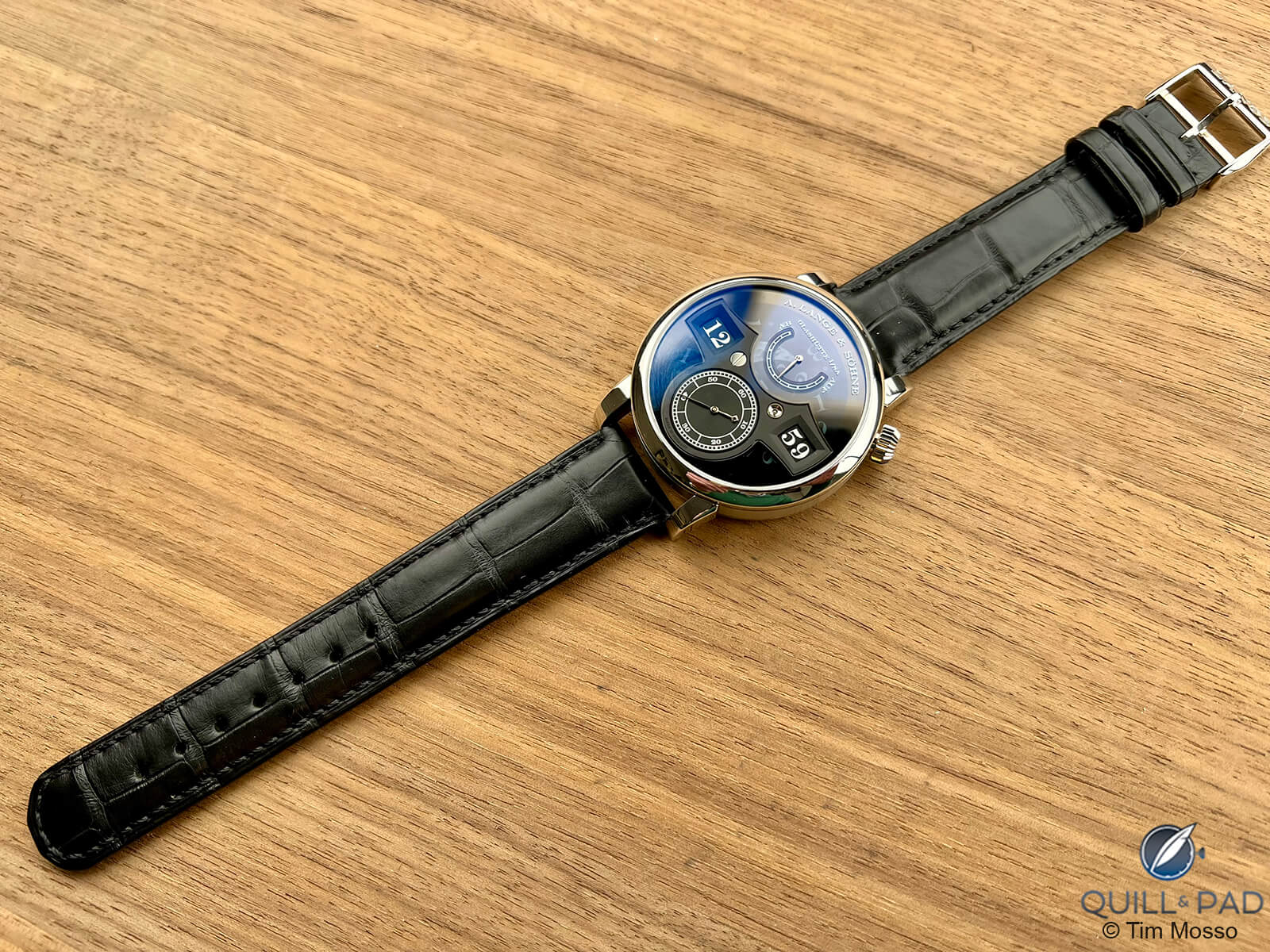
A. Lange & Söhne Zeitwerk Luminous
Prior to 2019’s Zeitwerk Date and the second-generation Zeitwerk it spawned, advancing through the individual minutes and hours was necessary to reach the desired time.
Grab a Snickers; you won’t be going anywhere for a while if the time displayed is far removed from the time desired.
Despite the reputation of time-jump watches as mediocre timekeepers, I’ve found that the Zeitwerk holds up on a chronoscope. While no ISO or chronometer status is claimed, my timing trials of several examples indicate that all versions of caliber L043 can cling to C.O.S.C./ISO 3159 timing specs.
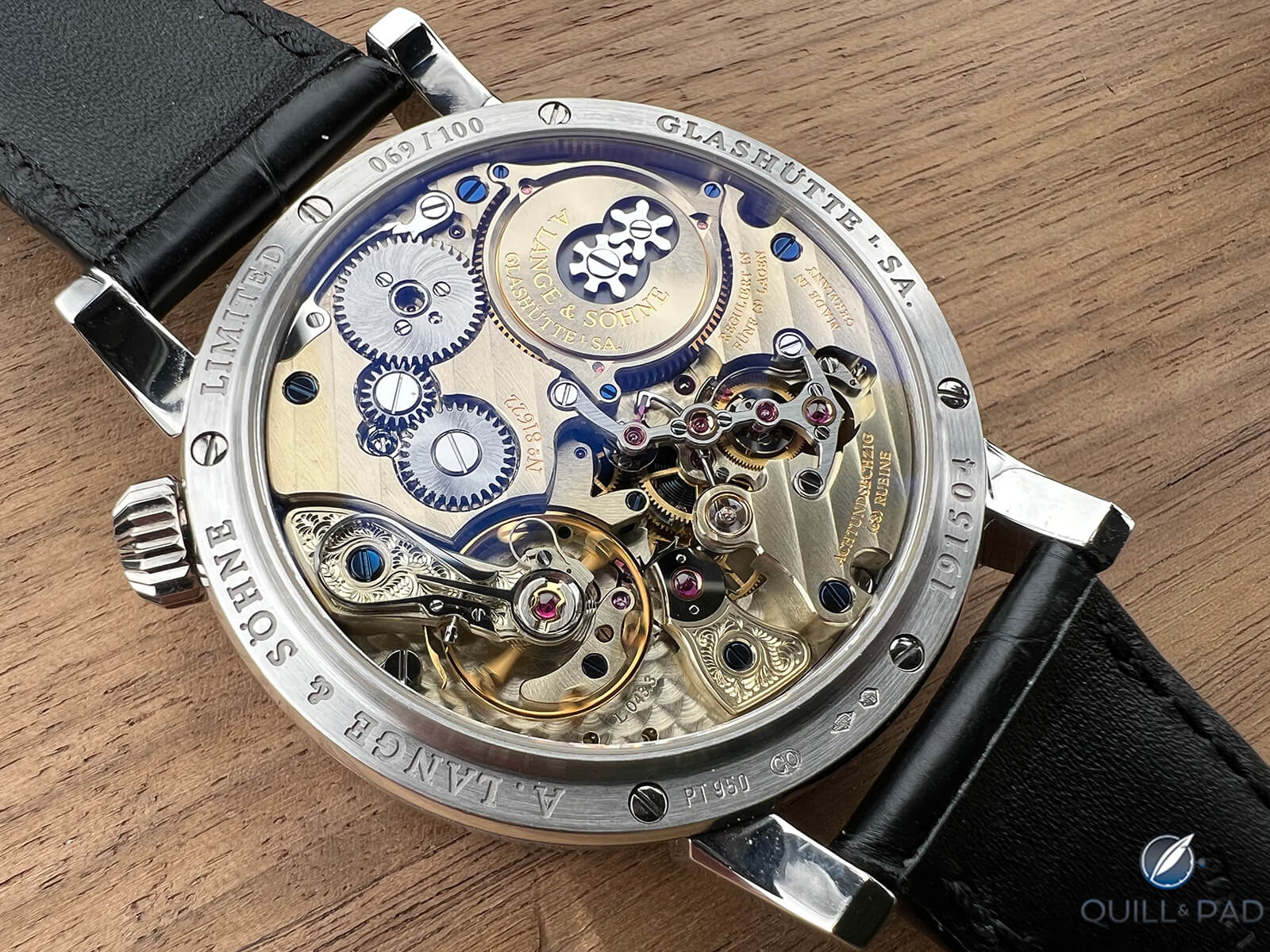
Movement of the A. Lange & Söhne Zeitwerk Luminous
The consistency of this movement is a product of a constant force system. While Lange’s original flagship model, the 1994 Tourbillon Pour le Mérite, employed a fusée-and-chain system that could trace its origins to the sixteenth century, the Zeitwerk achieves regularity with a twentieth-century solution: the remontoir. This movement is already vast at 33.6mm in diameter.
While a fusée-equipped Zeitwerk would have been eye-popping ecstasy, the sheer impossibility of packaging its 600+ parts, differential, and twin drums demanded a new solution.
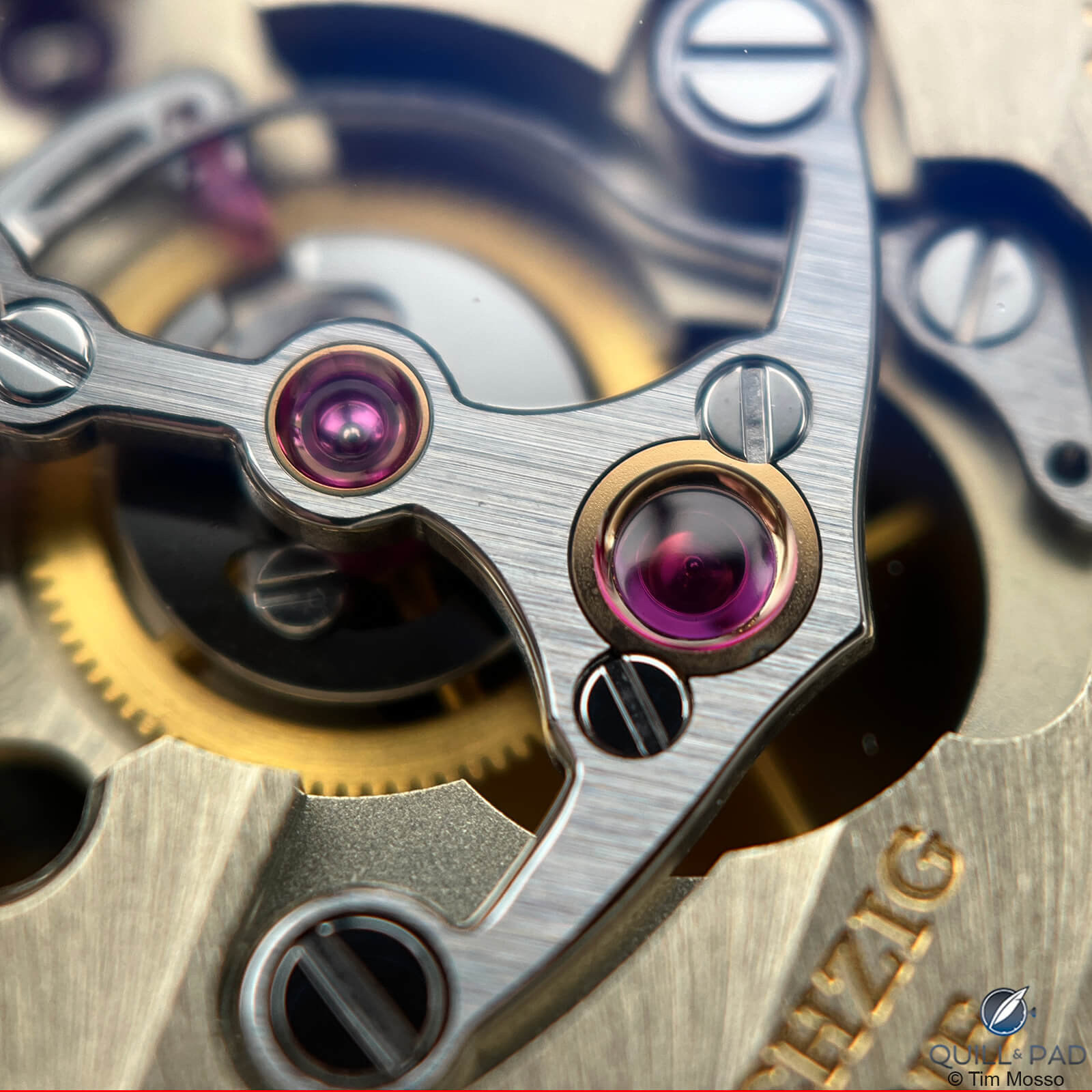
Remontoire bridge of the A. Lange & Söhne Zeitwerk Luminous
Fundamentally, a remontoir is an intermediate, short-term energy reservoir that ensures the mainspring never directly drives the escapement. Because the mainspring feeds the remontoir, and the remontoir always releases the same amount of energy to the escapement, the regulator can operate with little fluctuation in amplitude.
Moreover, the remontoir curbs a mainspring’s natural tendency to overdrive the movement when full and slow it at low wind.
There are many ways to implement a remontoir. F.P. Journe’s well-known solution involves a single linear spring, a second escapement, and a replenishment rate of once per second. Lange’s solution is far more complicated and commensurately cooler to look at. The energy of the barrel jumps the minute every 60 seconds. That energy is damped by a pinwheel of sorts that acts as an air brake.
—————————————————————————————————–
————————————————————————————–
The crooked steel bridge below the barrel includes a drivetrain that’s downstream of the power source; a locking lever with its own set of pallet stones permits the energy transfer from the barrel once per minute.
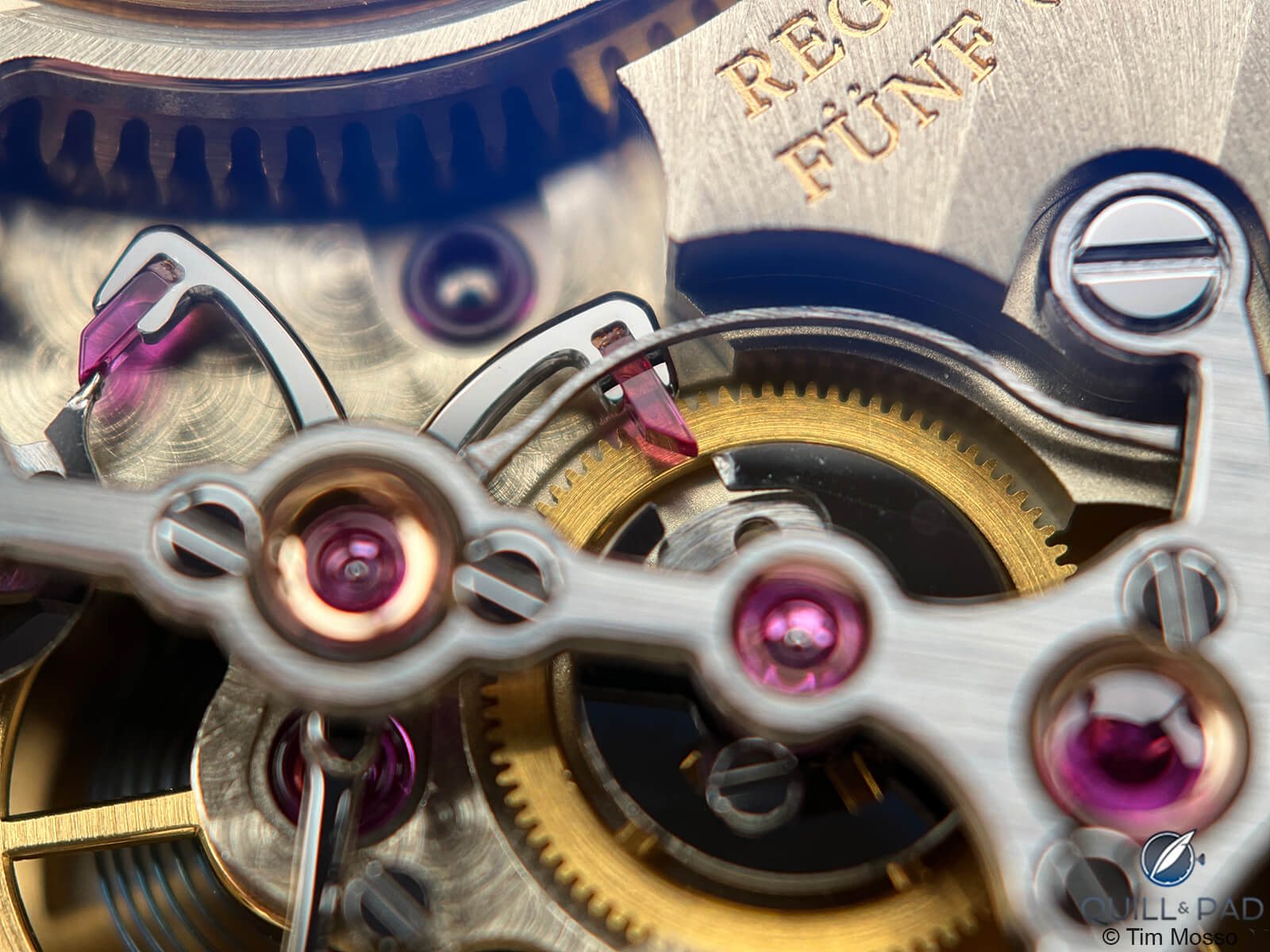
Remontoire mechanism of the A. Lange & Söhne Zeitwerk Luminous
There’s a clear sapphire adjacent to the balance pivot; this is the extended pinion of the fourth wheel that directly drives the seconds hand on the dial. It also acts as the timing instrument that locks and unlocks power flow through the remontoir.
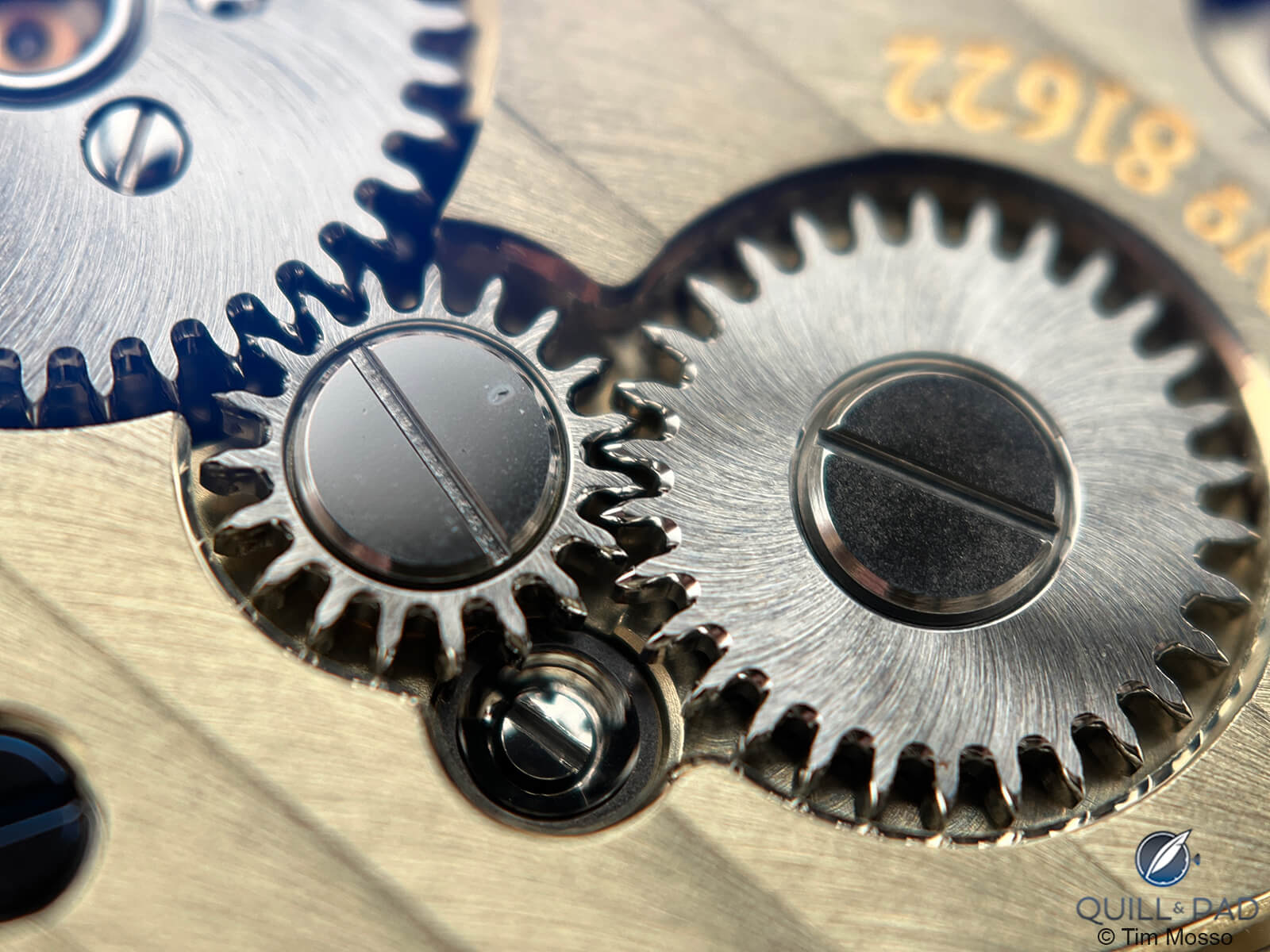
Intricate gearing of the A. Lange & Söhne Zeitwerk Luminous
Take a close look at the stack of twin third wheels at the inboard end of the remontoir bridge; this is the mechanism itself. One third wheel receives its energy from the barrel and it conducts that energy into a blue hairspring in between. That spring is the remontoir’s heart, and it drives the terminal end of the train that impulses the balance. At peak charge, the remontoir hairspring contains enough energy to run the watch for one minute.
As a result of this intermediate power source, the Zeitwerk beats its genre’s reputation for lax chronometry. Not only does it provide consistently strong timekeeping, but it prevents the juggernaut mainspring from overdriving the escapement. Were the big spring to drive the lever directly, the result would be immediate knocking, displaced pallets stones, and permanent damage.
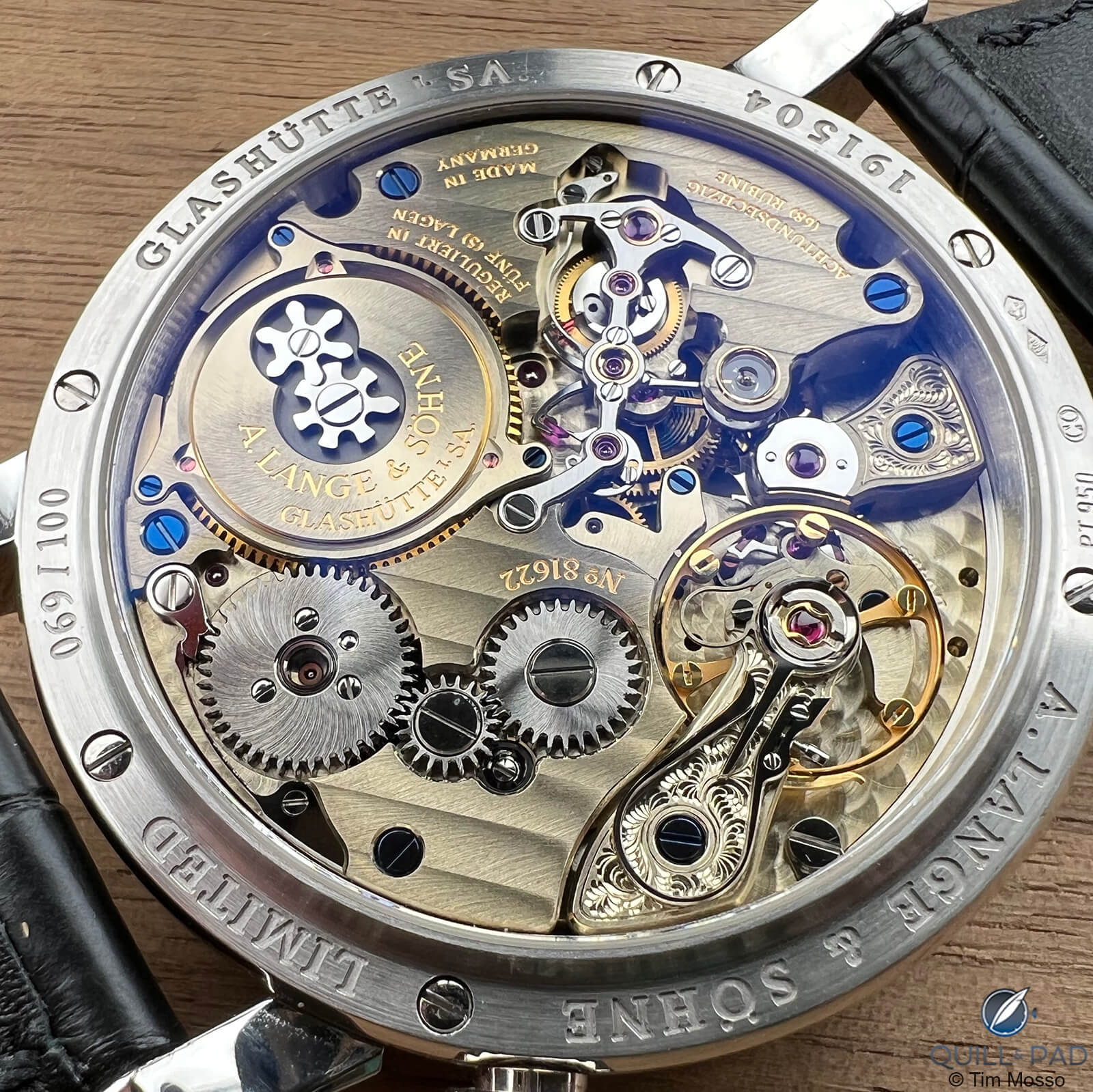
Movement of the A. Lange & Söhne Zeitwerk Luminous
Due to its massive potential to apply force, the Zeitwerk’s mainspring winds with a degree of resistance virtually unique in wristwatches. Perhaps a pocket watch could produce a similar effect, but one’s impression when winding a Zeitwerk is of singular awe. The action is silky and refined, but the spring’s backpressure commands respect. First-generation Zeitwerk models – single mainspring – include a dedicated bridge for the backside barrel arbor pivot.
Three blued screws and the surrounding three-quarter bridge hold back what must be a tidal wave of torque.
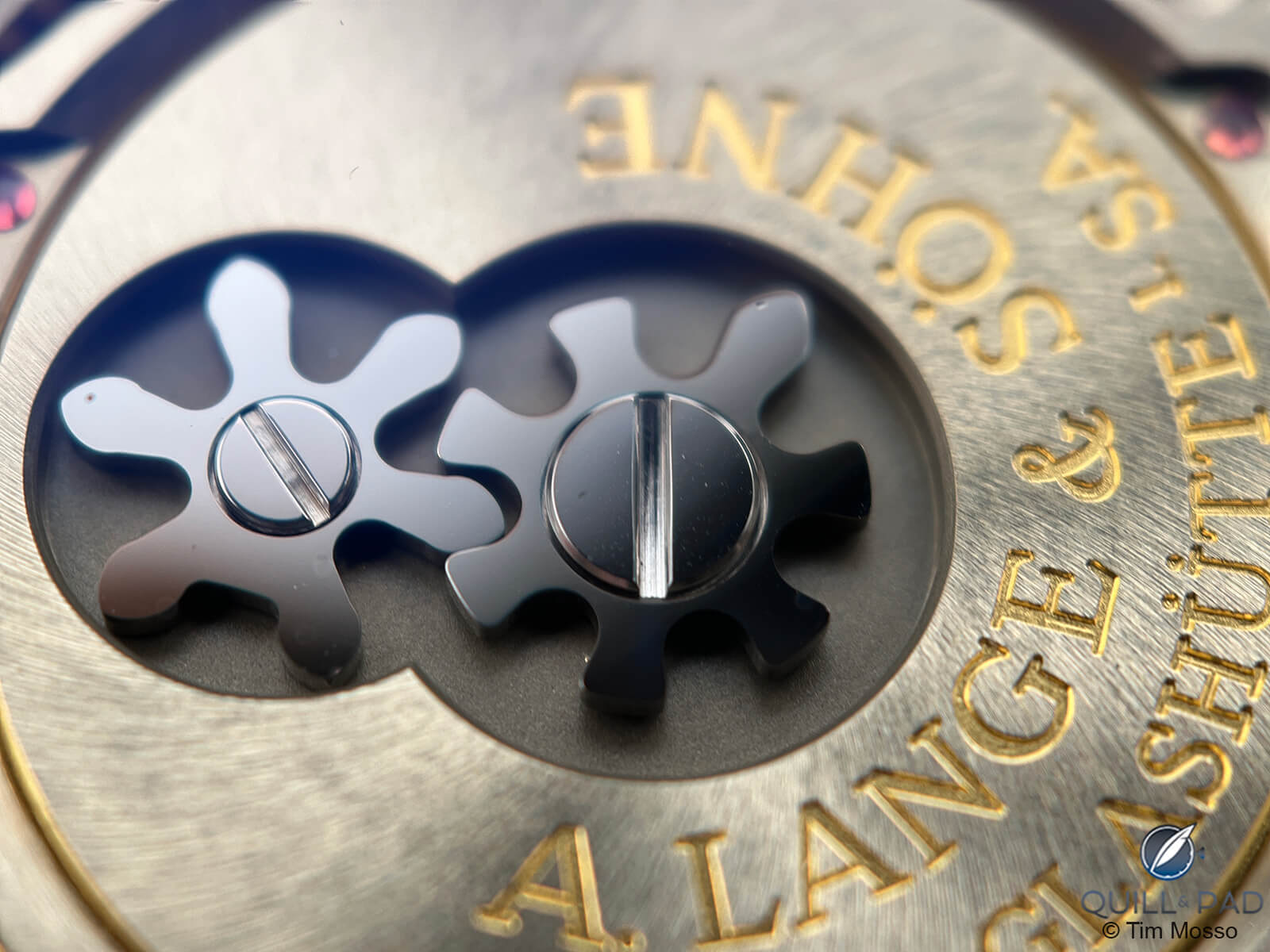
Maltese cross stopworks on top of the mainspring barrel of the A. Lange & Söhne Zeitwerk Luminous
Atop the barrel bridge, there’s a steel Maltese cross stopworks. Its specular finish is impressive, and its purpose is essential; keep the mainspring in an optimized state of wind to run the watch.
—————————————————————————————————–
—————————————————————————————————–
Back downstream at the escapement, the massive balance lopes at a leisurely 2.5Hz. What it lacks in rate it gains back with size and sheer inertia. There’s an overcoil hairspring that enables better timing stability in varying positions. The watch is tested in five orientations; that’s standard for many high horology watches and virtually all chronometers.
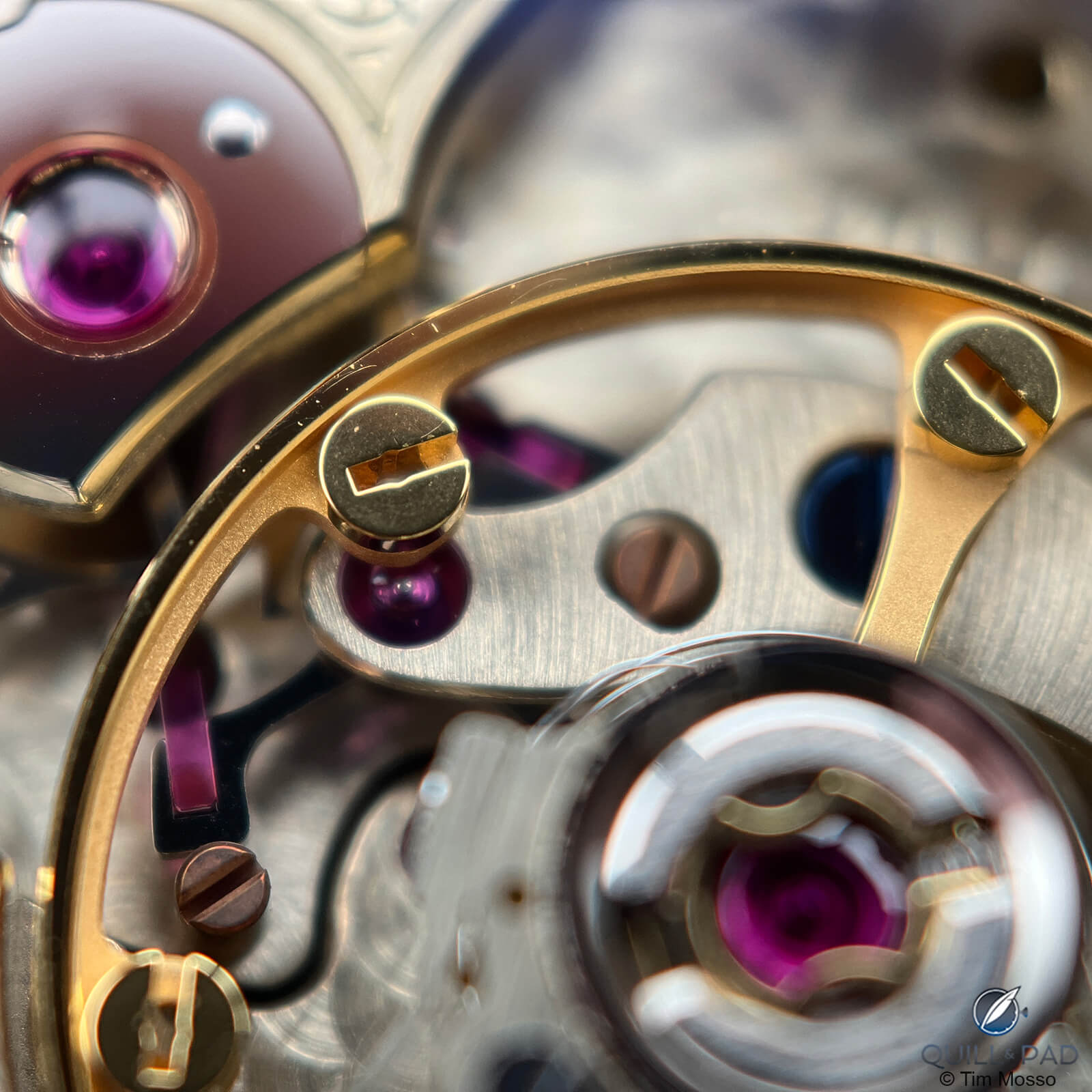
Eccentric masses on the balance wheel of the A. Lange & Söhne Zeitwerk Luminous
Notice the eccentric masses on the balance wheel. Despite the presence of a polished swan’s neck fine adjustment device and an adjustable stud holder, most regulation of this watch is performed by changing the orientation of the balance masses. For the most part, it works like a free sprung balance.
Finishing of the movement is calculated to please. Unlike most jump hour movements, which tend to combine specialized modules on top of mass-produced tractor bases, the L043.3 pictured here is an integrated caliber designed to incorporate the most impressive running gear on the caseback side. As a result, both scintillating architecture and decoration are on full display.
German silver isn’t silver, but it is an alloy of nickel, copper, and zinc. Copper is responsible for the golden hue of this material. As with many aspects of Lange movement design, this alloy was chosen for its historical link to the ancestral Lange company of Glashütte’s pre-communist era. With German silver, bright white steel hardware, violet pivot jewels, and head-blued screws, this a colorful movement.
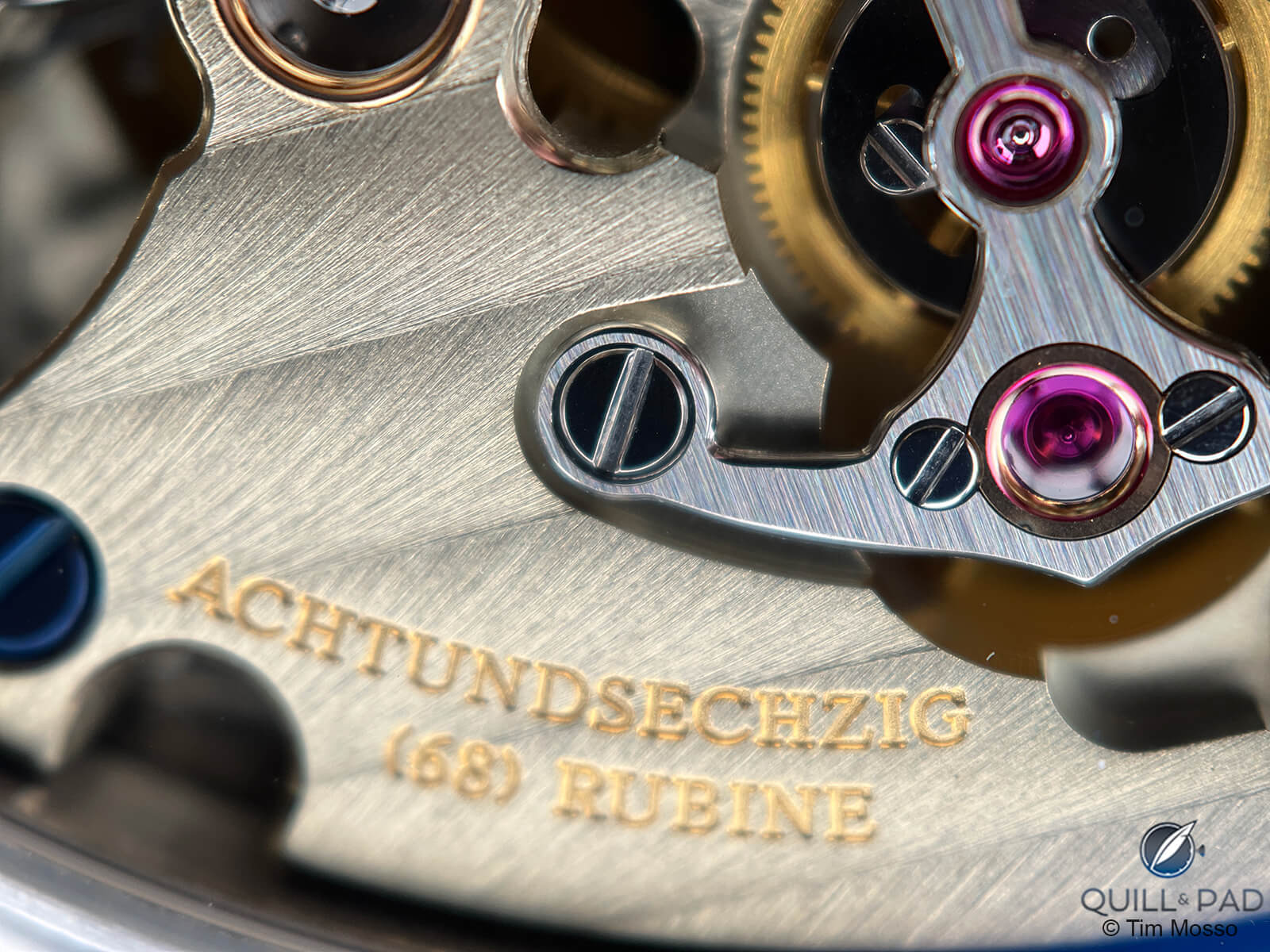
Beautiful stripes on the movement of the A. Lange & Söhne Zeitwerk Luminous
Stripes dominate the primary bridge that flanks the barrel assembly. We’re not in Switzerland, so they’re definitely, “stripes,” and not “côtes de Genève.” Mirrored bevels are present, but close inspection reveals them to be straight rather than rounded; likely, this indicates mechanical milling prior to manual buffing. The remontoir bridge is steel, satin brushed on its top, and chamfered on its edges.
—————————————————————————————————–
—————————————————————————————————–
Solarization highlights the crown wheel, offset ratchet wheel, and barrel cover. The spiraled effect serves a symbolic value and distinguishes these elements as front-end power source hardware. Upon close examination, both winding wheels feature an exquisite detail: beveled teeth. Although mostly aesthetic, the result is impressive to behold, rarely applied even at the highest level of watchmaking, and rewarding to observant owners.
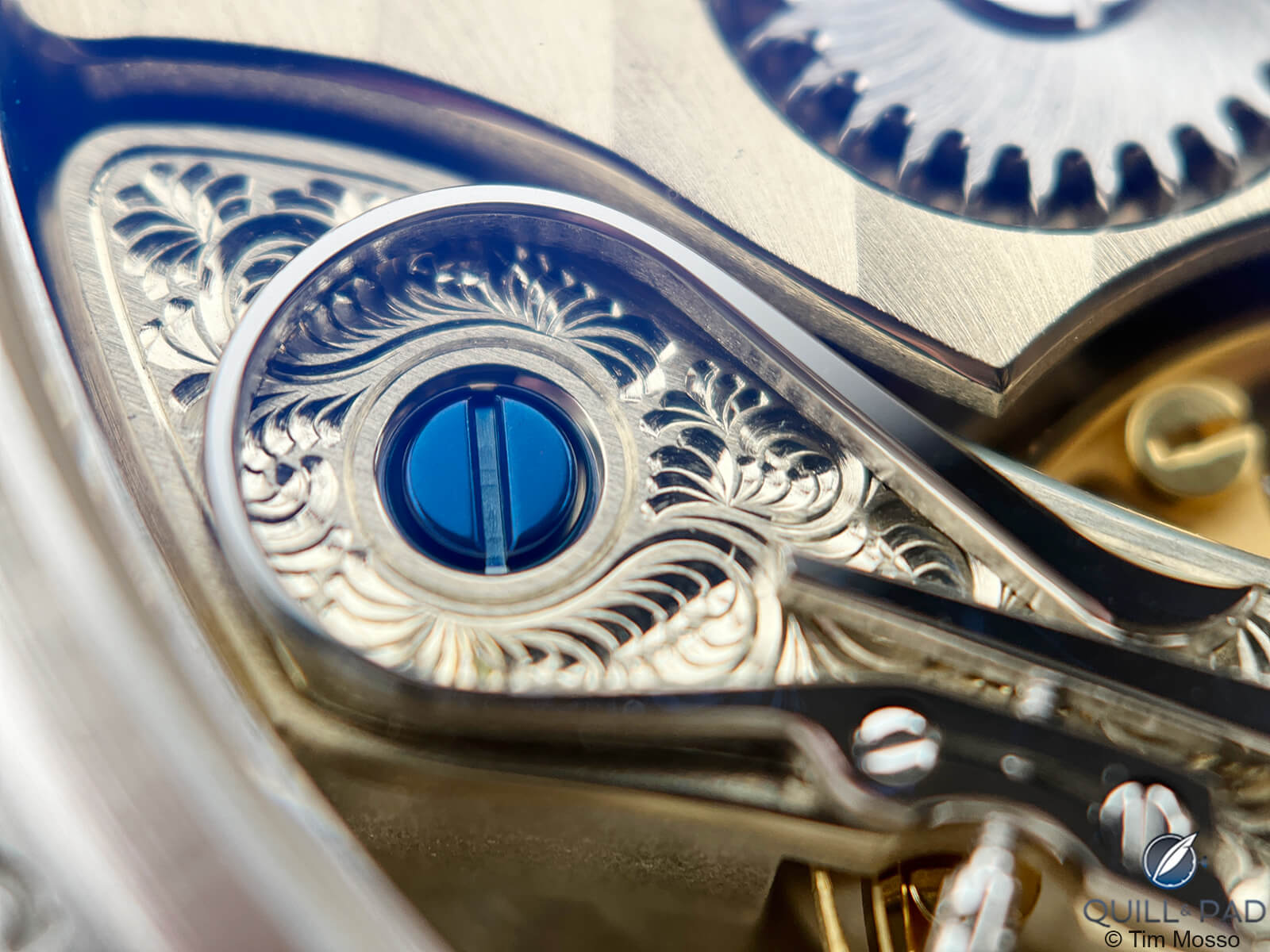
Hand engraved cock of the A. Lange & Söhne Zeitwerk Luminous
The cocks for the balance and escape wheel feature Lange’s signature finishing flourish, freehand engraving with a burin tool. Due to the truly artisanal nature of this process, no two examples ever will be identical. These scrolls and volutes are inseparable from Lange’s products and have proved to be influential in modern German watchmaking circles. Companies as varied as Nomos and Lang & Heyne have borrowed this trope.
Screws come in two forms: fired blue and black polished. Black polishing likely is achieved with a zinc plate while the blued screws are fired in a heater. The different colors seem to correspond to different purposes. Blue screws appear to fix stationary components in place; polished examples seem to be associated with adjustment, alignment, or tensioning.
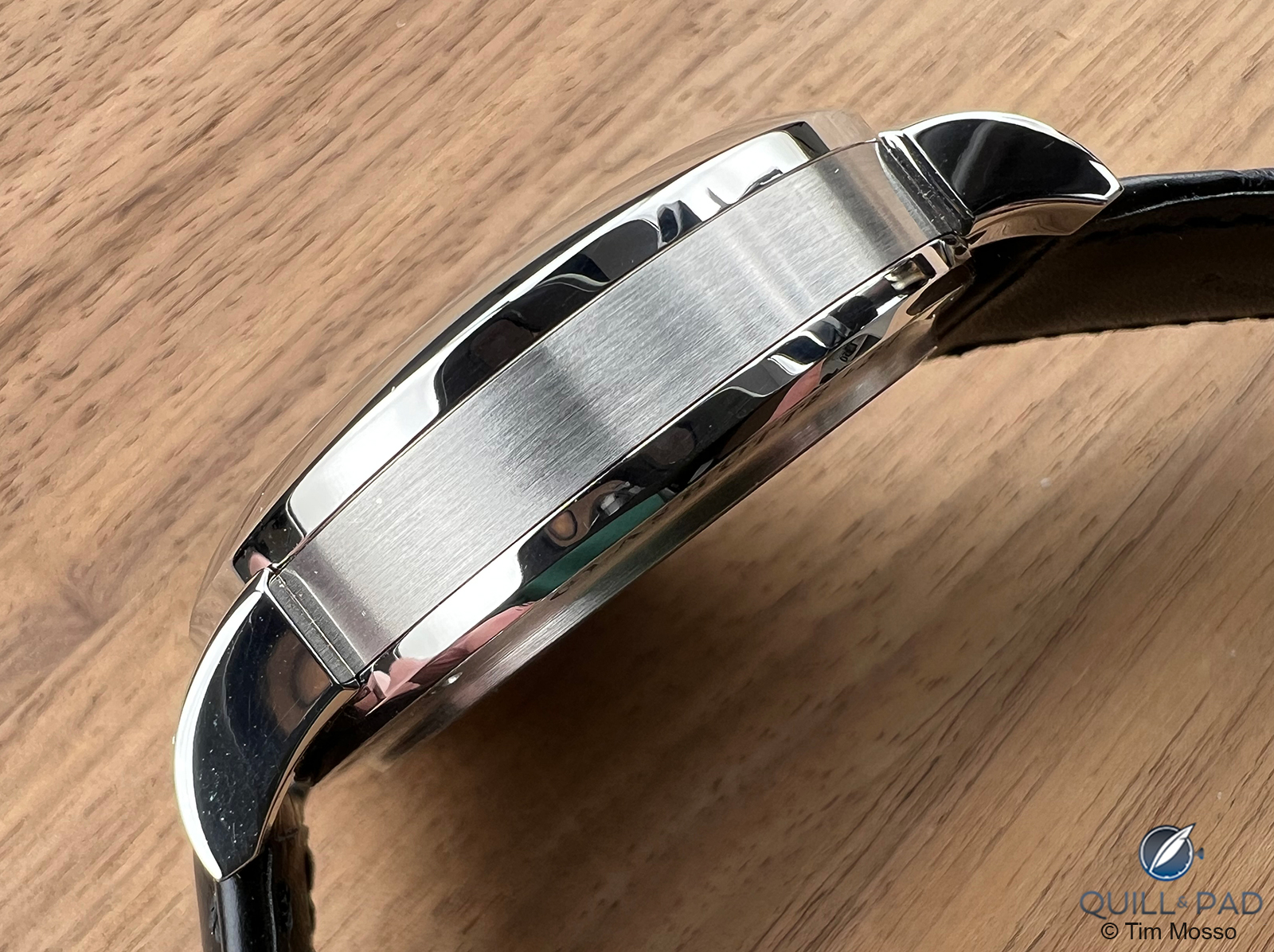
Caseband of the A. Lange & Söhne Zeitwerk Luminous
If any element of the Zeitwerk falls short, it’s the exterior. While caseback and dial are torrid centers of action, the 41.9mm white gold case feels somewhat portly and generic. Since virtually all Lange watches use some version of this case, it fails to match the revolutionary fervor that radiates off every other part of the Zeitwerk Luminous.
Further, the use of a pin buckle seems irreconcilable with the price, weight, and billing of this watch, which cost the equivalent of nearly $130,000 2023 dollars when it launched in 2010. Many collectors new to the Lange brand express surprise that even flagship models often require an upcharge for a folding clasp. But as gripe lists go, this is a short one.
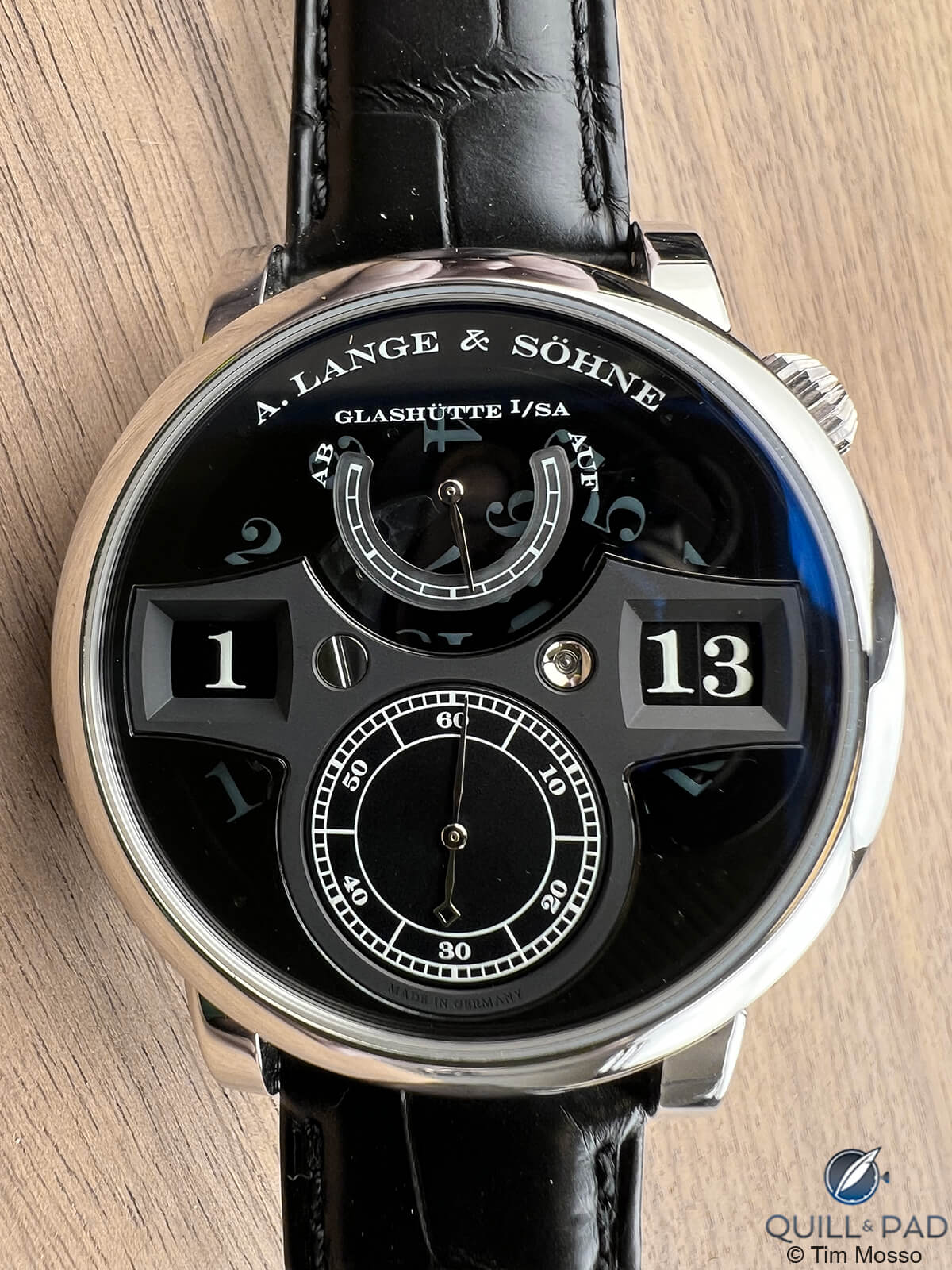
A. Lange & Söhne Zeitwerk Luminous
Every A. Lange & Söhne Zeitwerk variant rocks. It’s a heavy metal machine that marches to a different drum solo than the rest of its Saxon stablemates. Customers as disparate as retro grouches and software moguls have been drawn to the model line for its sheer dynamism. If Iron Maiden can make its peace with Lange’s heavy metal Phantom of the (Dresden) Opera, Eddie would rock one in a split second.
For more information, please visit www.alange-soehne.com/us-en/timepieces/zeitwerk/zeitwerk
Quick Facts: A. Lange & Söhne Zeitwerk Luminous
Reference Number: 140.035
Edition Number: 100 pieces, 2010 model year
Case: Platinum; 41.9mm x 13.1mm thick x 49.7mm; 30-meter water resistance
Dial: Smoked black sapphire with German silver “time bridge” center; luminescent time discs
Movement: L043.3, manual, 36-hour power reserve, hacking, 2.5Hz, overcoil, remontoir, variable inertia balance, stopworks, 33.6mm diameter
Functions: Digital hours, tens of minutes, and minutes; power reserve indicator
2024 Market Value: Approximately $290,000
* Tim Mosso is the media director and watch specialist at Watchbox. You can check out his very comprehensive YouTube channel at www.youtube.com/@WatchBoxStudios/videos.
You might also enjoy:
A. Lange & Söhne Richard Lange Tourbillon Pour le Mérite Reviewed by Tim Mosso
Behind the Lens: Two 1815 Chronographs from A. Lange & Söhne
Why I Bought It: A. Lange & Söhne Pour Le Mérite Tourbillon
A. Lange & Söhne Datograph Perpetual Tourbillon: A Machine with Heart and Soul
Leave a Reply
Want to join the discussion?Feel free to contribute!

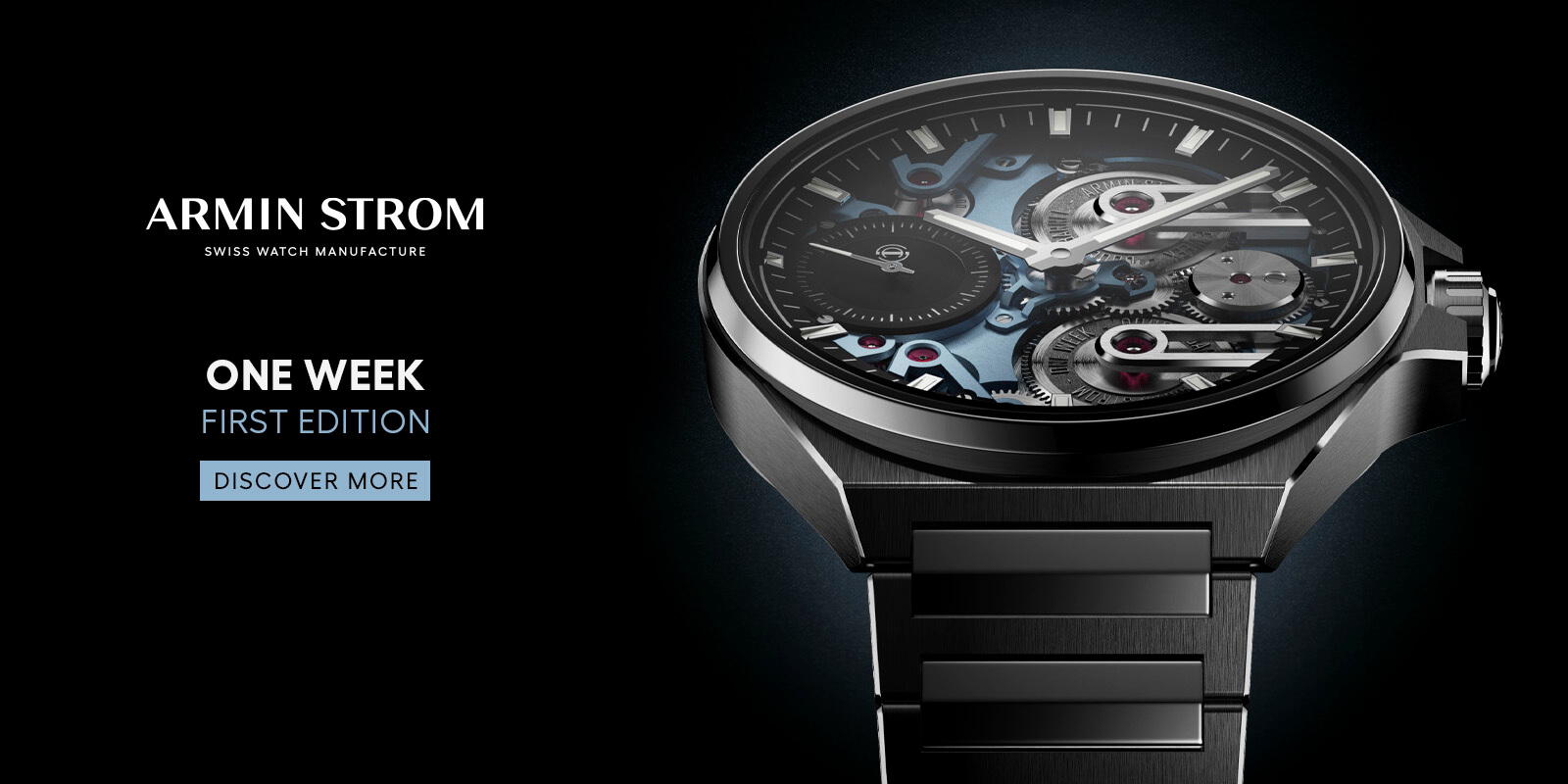
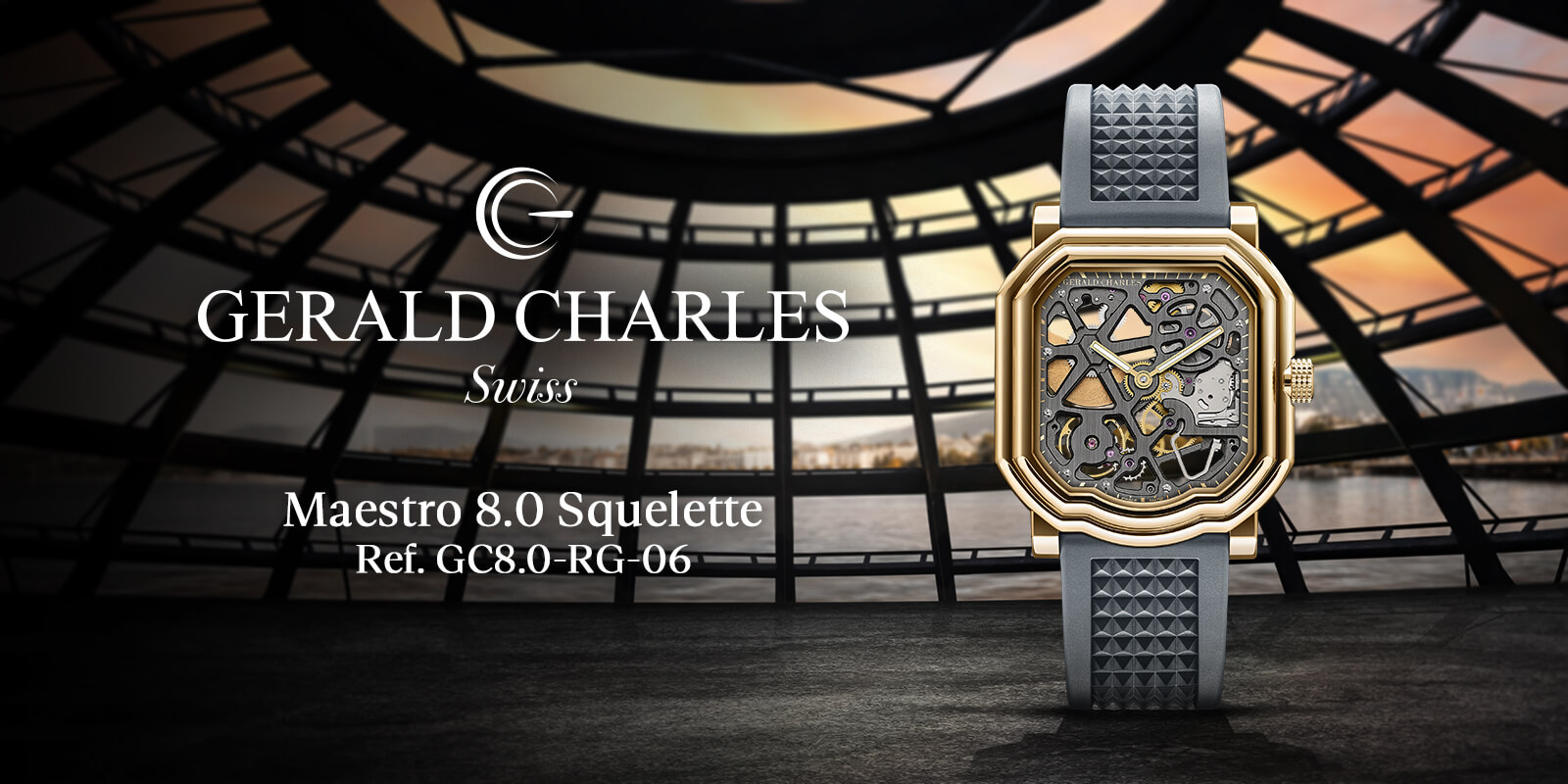
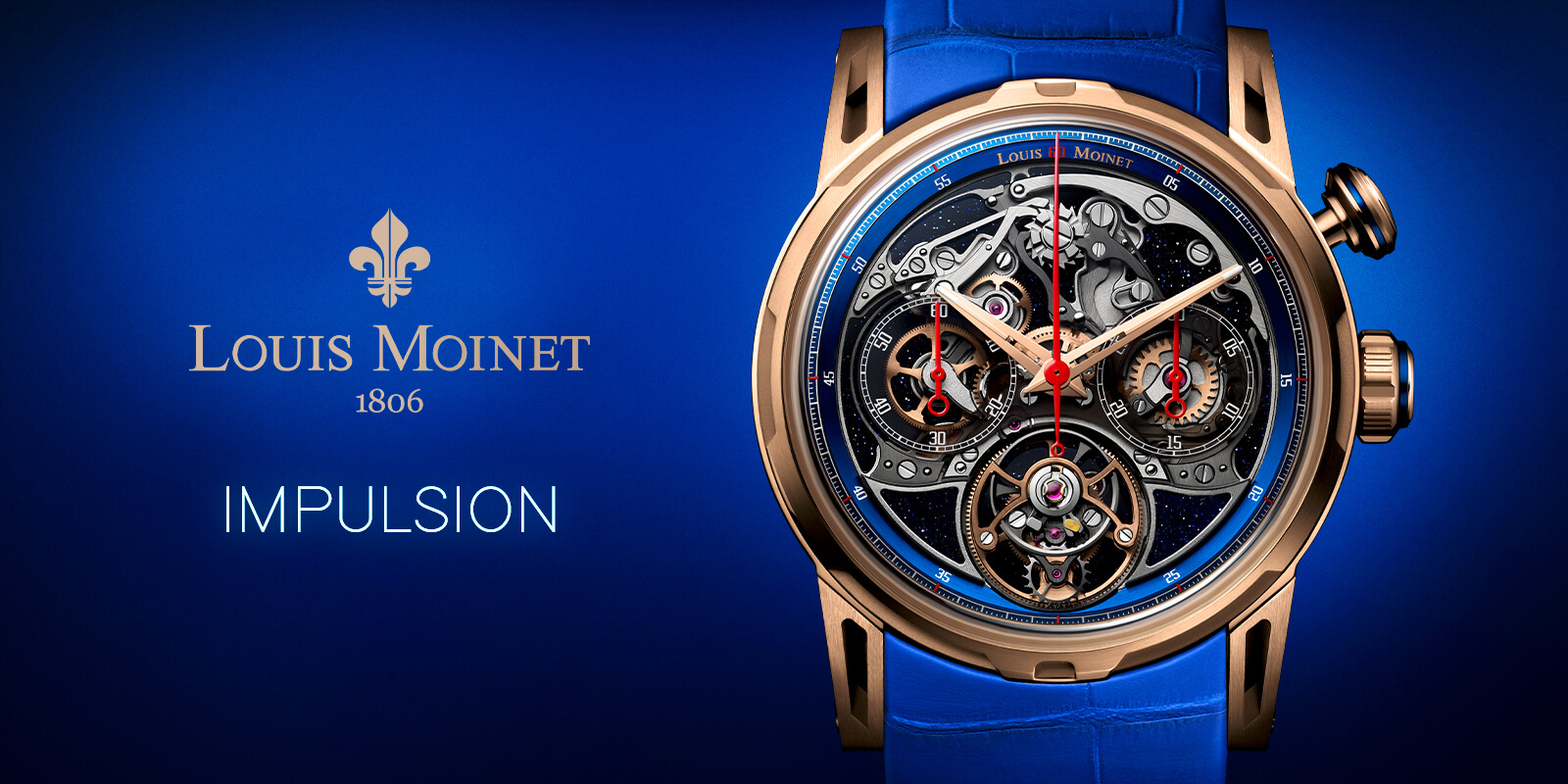
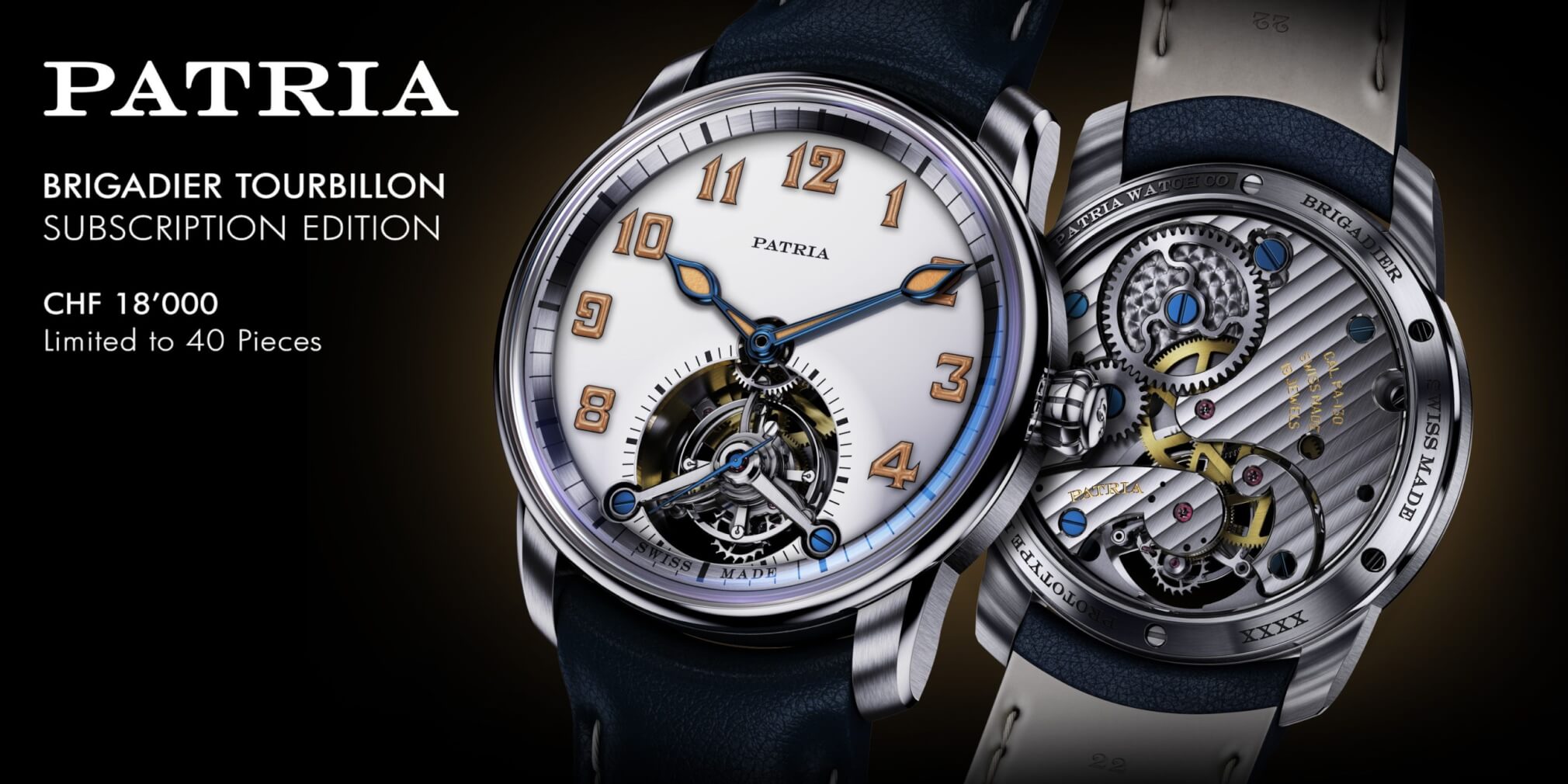


Dear Tim,
‘Black polishing likely is achieved with a zinc plate’ – it is achieved with a tin plate (tin = Zinn in German, not Zink, what is source of many mistakes)
As a reference: https://www.alange-soehne.com/eu-en/manufacture/art-of-watchmaking/finishing-and-engraving
WBR
Serge